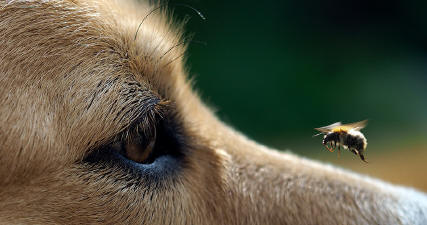 (9/2018) In addition to heat and humidity, summer also brings bees and wasps. While anaphylactic allergic reactions to bee stings are uncommon in animals, local swelling and pain at the sting site is fairly typical. The location of the sting is also pretty consistent within a species. Cats tend to get
stings on their paws and legs from batting at the bee. Dogs are usually stung on their nose or mouth from trying to sniff or bite the bee. Horses seem to get stung on their body and neck as they'll inadvertently antagonize the bee by accidentally bumping the nest. For this reason it is also fairly common to see multiple stings on a horse since there is an entire nests worth
of angry bees trying to get them.
(9/2018) In addition to heat and humidity, summer also brings bees and wasps. While anaphylactic allergic reactions to bee stings are uncommon in animals, local swelling and pain at the sting site is fairly typical. The location of the sting is also pretty consistent within a species. Cats tend to get
stings on their paws and legs from batting at the bee. Dogs are usually stung on their nose or mouth from trying to sniff or bite the bee. Horses seem to get stung on their body and neck as they'll inadvertently antagonize the bee by accidentally bumping the nest. For this reason it is also fairly common to see multiple stings on a horse since there is an entire nests worth
of angry bees trying to get them.
While horses will usually get multiple stings, being flight animals, they run away from the swarm pretty quickly. Typically they don't get stung more than a handful of times. The exceptions to this are when they have been confined. I've seen several cases where owners haven't used a stall, a run-in shed, or a horse trailer in months and fail to thoroughly inspect the
structure for nests before putting their horse inside. Owners forget that different species of bees and wasps tend to select different types of locations for their nests. If you only look up and check for wasp nests along the building roof line, you may miss the nest of aggressive yellow jackets in the ground just outside the stall door. A nest can appear in days.
Horse trailers are a frequent location for bee and wasp nests. Luckily when the nest is in a horse trailer, the owner is often present when the horse gets stung and starts to panic. Usually the owner is then able to get the horse off the trailer before he gets stung too many times, and injures himself and the trailer. Of course this frequently creates a future trailer
loading challenge for the horse that the owner will have to retrain.
Some of the worst bee sting reactions I have seen have been when the owner puts the horse in a stall that hasn't been used for awhile and there is a nest in it. The owner may not notice for hours that their horse is being stung. While numerous stings are not frequently fatal to the horse, they can seriously hurt themselves when they panic and try to break out of the stall.
I did a laceration repair on one horse and as I was suturing the horse back together the owner kept telling me that she had no clue why the horse went crazy and broke out of the stall. She told me that he was normally very well behaved in the stall. She was suspicious that perhaps one of her neighbors or someone had been setting off fireworks too close to the barn and if that
was what had spooked him. It wasn't until after I had finished treating all of the horse's wounds and the owner went to put the horse back in the stall, that she was stung and saw the nest. Obviously a different stall was found for the horse until the nest was removed.
While I have been very fortunate to have not had a patient die from a bee sting, it does happen. One of my colleagues had to euthanize a horse that had been stung multiple times and had so much facial swelling that the horse was practically blind, causing it to run through a fence and fatally injure itself.
While you can't always prevent your dog or cat from getting stung when they encounter a bee in the yard, a large proportion of the bee and wasp sting injuries to horses are often preventable. In the warmer months make sure you check stabling and trailers for bees and wasps before enclosing your horse. Hopefully by inspecting stalls and trailers for bees ahead of time your
horse can avoid injury and expensive vet bills.